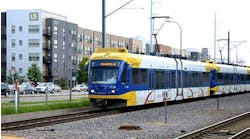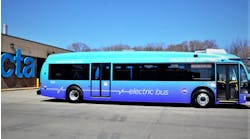For Long Beach Transit (LBT), keeping its vehicles in top condition is critical to providing a safe and reliable bus service for its 29 million annual boarding passengers. When Rolando Cruz, LBT's executive director and vice president of Maintenance and Facilities, joined the organization 10 years ago, Long Beach Transit had little ability to analyze data about its fleet of 220 vehicles to support its maintenance operations.
"All we had were the old green-screen systems with no true data to analyze the service history of each vehicle," explains Cruz. "We could generate work orders and that was it. We had no way of performing analysis besides running reports that were standard and fixed — it just didn't give us the ability to see where we were doing well and where we weren't."
LBT was looking to analyze data to better predict and plan maintenance activities and costs to optimize operations by improving the way work orders were developed and segmented according to the type of work.
"Previously, we could only schedule work by the day," says Cruz. "Instead, we wanted to be able to segment the scheduling of work according to the job. We also wanted some flexibility to change the way we could schedule work orders as we grew."
Utilizing Technology
To tackle the problem, LBT implemented an enterprise asset management (EAM) system from Mincom, Mincom Ellipse.
Since implementing the solution, Long LBT has learned new ways to optimize the maintenance and operation of its assets in different areas.
One such area LBT was looking to optimize was effectively predicting — and minimizing — the wear and tear of parts, such as brakes. With LBT vehicles running an average of 300 miles each day, wear and tear is inevitable.
"In the transit world, the wear and tear of parts is an ongoing challenge," Cruz say. "It was important for us to get better visibility of the condition of each vehicle so we could reduce downtime. In the event that one of our vehicles required service, we needed to know we could be instantly ready with parts and labor."
With buses constantly stopping and starting in traffic, servicing brakes is a common maintenance activity. It is also a very time-consuming job. "It was an immediate area we knew we could improve."
With the EAM system, LBT developed a historical record of brake jobs, enabling them to study patterns and predict when brakes would need replacing. "Previously, we had found that some of our vehicles were doing 8,000 miles before requiring a brake job, while other vehicles could manage 30,000 miles," says Cruz. "This was such a large range and we needed to work out why."
With the new system, the mechanics can analyze why brake jobs were performed, where the problems were and iron out any inconsistencies. The aim was for all vehicles to average approximately 27,000 miles before a brake change was needed. Within a couple of years, all vehicles in the fleet were meeting this standard.
"Using Mincom Ellipse, we've been able to decrease our maintenance activity by 35 to 40 percent," says Cruz. "Previously we were performing around eight to 10 brake jobs a year. Now, we hardly do any."
The system has saved LBT money, too. Cruz states, "Not only are we doing less maintenance on areas like brakes, more of our fleet is staying on the road and out of the workshop."
Putting Information to Work
According to Cruz, the greatest benefit from implementing this system is the ability to customize work orders according to their needs, as well as being able to analyze data by any category for maintenance planning. "If there was one word I would choose to describe this new functionality, it would be flexibility," he says.
"We are able to provide upfront instructions to our mechanics about what's required, suggest parts and estimate labor time — it's all there. And if we ever have a change to a job, new information and instructions can be generated and read by the mechanics immediately. Our mechanics are very spoiled now — when they get a job, they know what's expected of them, what materials they should be using and what parts of the job are related to them."
Previously, the only way LBT could schedule any preventative maintenance was by day. Now, the organization generates different work orders according to the situation. Some of their maintenance is scheduled by day, others by miles and others based on the condition of the vehicle being serviced.
Above all, Cruz says implementing an EAM system has allowed the team to become much better planners. "Today, a lot of infrastructure-based organizations are talking about PAS 55 — a best-practice guide for the whole life cycle management of physical assets. Using the PAS 55 approach, we're now able to manage the entire life cycle costing of our assets, from the moment they are purchased to the time they are replaced.
"With the support of Mincom, Long Beach Transit has been optimizing the entire asset life cycle for years — while other transit organizations are still struggling to understand the concept."
LBT can now track different vehicle components, enabling them to compartmentalize problem areas that were considered to be too costly or safety issues. "In doing so, we are able to predict — and minimize — our maintenance requirements."
"Thanks to Mincom, we've put in place an active replacement strategy for our engines, transmissions and other major components susceptible to wear and tear. The result: a fleet in optimum condition and a reliable, quality service for Long Beach Transit passengers."
LBT is planning to upgrade to the newest release of Mincom Ellipse (v8) in the coming year in order to take advantage of its field-enablement applications. It also plans to implement Mincom's LinkOne electronic parts catalog solution for better parts management.
"By developing a more comprehensive picture of asset management, Long Beach Transit not only provides a great bus service, but also manages public funds in the most responsible, forward-thinking way."
Cruz adds, "For others looking to implement an asset and work management solution with similar results, we believe our most important strategy was involving employees at all levels. We first created a team that included mechanics, storekeepers and supervisors to document current business practices, and then developed a set of best practices using our EAM system. We even learned how we could change a few of our practices and thus improved our way of doing business moving forward."


